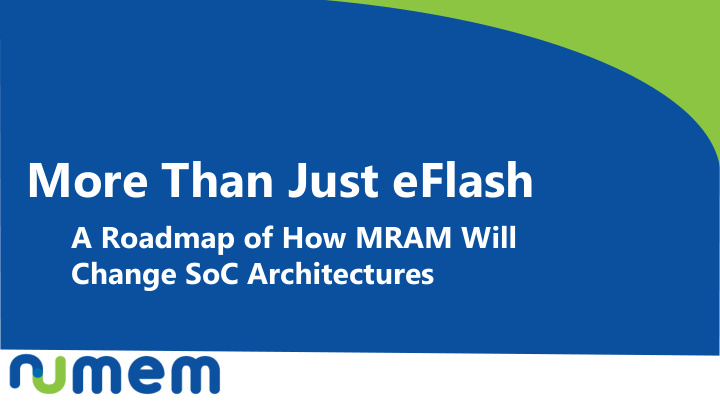



More Than Just eFlash A Roadmap of How MRAM Will Change SoC Architectures
Introduction • For many years, MRAM has been “right around the corner.” Bitline Its been billed as: SRAM killer eFlash replacement Enabler of instant on computers • At least 3 major foundries are preparing to bring eMRAM into production Production expected by end of 2018 Currently 28nm/22nm; roadmaps for 14FF/12FF and below Sourceline • So how exactly will MRAM fit into SoC architecture initially and as the technology continues to evolve? Numem Confidential and Proprietary Information..
Comparison Overview • Speed typically 10-100x faster than eFlash while SRAM MRAM eFlash still 2-10x slower than SRAM Read Time <1-2ns 2.0-20ns 10-100ns • Active power typically 10-50x lower than eFlash Write Time <1-2ns 10-1,000ns 10us-10ms 2-4x higher than SRAM for Read 0.1-0.4 0.2-2.0 uA/ 1-100 Read Power 4-200x higher than SRAM for Write uA/MHz/b MHz/b uA/MHz/b • Standby power near zero 0.5-2.0 2.0-400 100-2000 uA/ Write Power uA/MHz/b uA/MHz/b MHz/b No bitcell current unlike SRAM Core voltage only reads unlike eFlash Stdby Power High Low Med / Low Process Cost Baseline 5-10% 15-25% • Significantly lower cost than either memory ~½ the area of SRAM 6T + low 2T + mid 2T-10T + high Area Lower wafer cost and as much as 5x smaller than overhead overhead overhead eFlash Numem Confidential and Proprietary Information..
Cost Advantages: Displacing eFlash • Preliminary driver of change is cost MRAM MRAM 15-20% cost reduction expected (within scaling Core CPU Logic Core CPU Logic Core CPU Logic (Data) (Data) eFlash (Data) trend) > ~10% wafer cost reduction due to larger geometry, L1 Cache L1 Cache L1 Cache backend layers L2 Cache L2 Cache L2 Cache MRAM MRAM > ~5-10% die size reduction, depending on ratio of die (S&D) (S&D) eFlash SRAM SRAM SRAM spent on eFlash / MRAM (S&D) (S&D) (S&D) (S&D) L3 Cache L3 Cache L3 Cache SPI SPI SPI IO’s / Analog IO’s / Analog IO’s / Analog • Reduced cost/bit will shift boundary for internal / external NVM usage Power savings Board route reductions SPI Flash SPI Flash SPI Flash Fewer pass-through costs Numem Confidential and Proprietary Information..
Performance Implications: MRAM v SRAM • Store&Download Schemes Unnecessary 2-4x Speed / Power of SRAM with no idle power MRAM MRAM MRAM MRAM MRAM MRAM Savings can enable larger XIP area Core CPU Logic Core CPU Logic Core CPU Logic Core CPU Logic Core CPU Logic Core CPU Logic (Data) (Data) (Data) (Data) (Data) (Data) • L3 Cache L1 Cache L1 Cache L1 Cache L1 Cache L1 Cache L1 Cache Bit-Alterable design enables SRAM-type usage No idle power L2 Cache L2 Cache L2 Cache L2 Cache L2 Cache L2 Cache MRAM MRAM MRAM MRAM MRAM MRAM Area / Power savings can enable larger cache (S&D) (XIP) (XIP) (XIP) (XIP) (XIP) SRAM L3 Cache (MRAM) L3 Cache (MRAM) L3 Cache (MRAM) (S&D) L3 Cache L3 Cache L3 Cache • L2 Cache IoT and other power sensitive applications will benefit SPI SPI SPI SPI SPI SPI IO’s / Analog IO’s / Analog IO’s / Analog IO’s / Analog IO’s / Analog IO’s / Analog Performance differences will make this a tougher boundary to cross • L1 Cache / Main SRAM Low duty cycle applications (e.g. remote sensors) “Instant On” valued over performance; NVM nature preserves state of cache SPI Flash SPI Flash SPI Flash SPI Flash SPI Flash SPI Flash when off Limited application expected Numem Confidential and Proprietary Information..
Technology Availability • eFlash has run ~3 technology generations behind logic 40nm While some announcements have been made for 28nm eFlash, most foundries 28nm indicate that 40nm will be the last node 20nm 14nm • MRAM will intersect on this same trend line, but accelerate from there 10nm 2 nd generation MRAM should shave 2-3 7nm years off this trend Logic Process 3 rd generation MRAM should be just 1 year behind the logic process eFlash Process MRAM Process Numem Confidential and Proprietary Information..
Closing • 2018 will see the first broad availability of MRAM from major foundries • Whether your priorities are cost, performance, or time to market, MRAM can enhance any SoC architecture • Numem is ready to help companies lead in MRAM deployment Over 45 years of experience in MRAM design Leading edge density, performance, and power Focus on helping customers bring their products to market Numem Confidential and Proprietary Information..
Recommend
More recommend